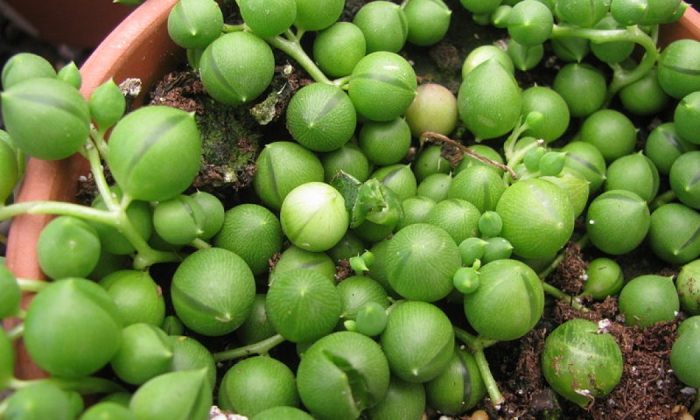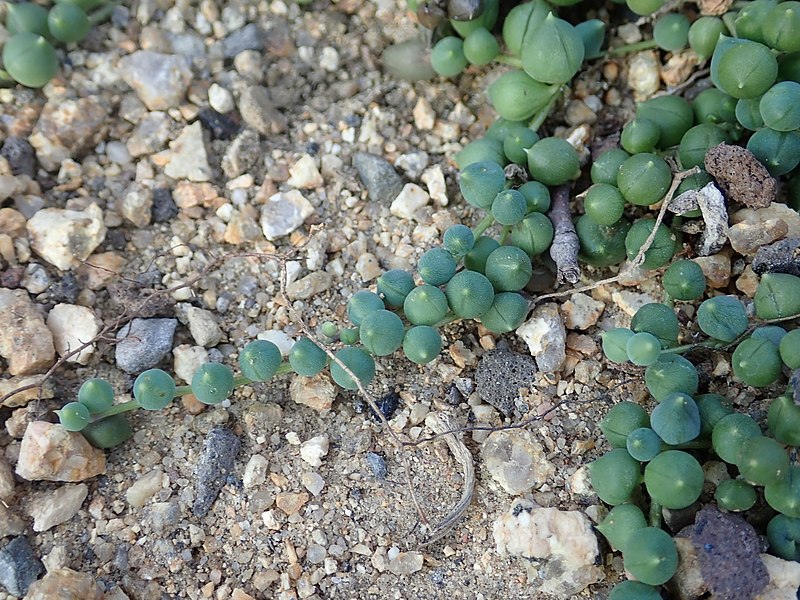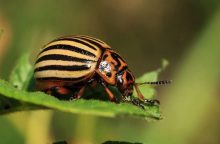Strings of pearls. How to grow this beautiful plant

String of pearls (senecio rowleyanus) is a succulent and as any succulent it needs plenty of sun and little water, but string of pearls a bit of an exception. Rather than direct sunlight it prefers indirect light – but in large quantities. Especially young plants, which are still small and did not grow overhanging branches yet, cannot tolerate strong direct sunlight. If you provide too little light, the plant will have a tendency to spread too much, its leaves will shrink and the plant will grow weaker.
Watering
Abundant watering is harmful, but many people think that because this plant is succulent you do not need to water much as it comes from desert-like environment. The truth is that the soil should be dry before watering and string of pearls can tolerate short-term drought, but cannot tolerate too much water. Yes, these plants come from dry areas, but they still require moist air and a dry substrate. Both at the same time… Frequent watering can hurt them, but to go around it you should sprinkle leaves from spring to fall. Sprinkling works great. Further, remember that mature, fully-grown and tall plants need less water than young plants.
Photo: Salicyna https://commons.wikimedia.org/wiki/File:Senecio_rowleyanus_2019-12-13_5983.jpg
Winter care
Central heating systems create drier air and this may cause dry leaves. You cannot cure dry leaves by watering. You may even harm the plant. To help, place the plant in a clean place, away from radiators, and keep the substrate very lightly moist. Keep sprinkling leaves. You may also place a humidifier near the plant. In winter, you should definitely limit watering, but the substrate must not dry out completely. Place the plant at a visible place so, you can check it and keep the temperature between 13 and 16 °C. Limit watering only to the necessary minimum.
Suitable substrate
Senecio rowleyanus requires a very permeable substrate. You can use soil designed for succulent plants or you can use a mixture of all-purpose soil with added coarse sand, vermiculite and fine gravel. During the vegetation period it is a good idea to use a liquid fertilizer for succulents. Use once every two weeks. When the autumn comes, you should stop fertilizing completely.
Propagation
Propagation is easy. Long shoots need to be pruned from time to time to help the plant create a dense shape and the cut parts can be used to plant new plants. You can use the “propagation” method to save dying plants. Even if you made few major mistakes or if you overwatered too much or used completely wrong substrate, or even if the plant starts to rot, there is still a chance that you will grow a new plant from cuttings. The shoot should be at least 10 cm long and should be healthy. Depending on the width of the pot, you can plant two to five shoots in one pot. Make sure that leaves do not overlap – you should also not leave too much space between individual shoots. Sprinkle replanted shoots every few days to keep the substrate slightly moist and keep it in out of direct sunlight. It will take a few weeks for the shoots to take root.
Preview photo: Flickr user Forest and Kim Starr https://commons.wikimedia.org/wiki/File:Senecio_rowleyanus_leaves.jpg

Gardening is my hobby, I have a lot of experience and I am happy to share it.









0 comments